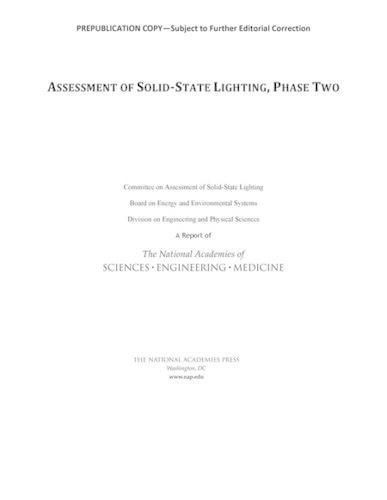Assessment of Solid-State Lighting, Phase Two
National Academies of Sciences, Engineering, and Medicine,Division on Engineering and Physical Sciences,Board on Energy and Environmental Systems,Committee on Assessment of Solid-State Lighting, Phase 2

Assessment of Solid-State Lighting, Phase Two
National Academies of Sciences, Engineering, and Medicine,Division on Engineering and Physical Sciences,Board on Energy and Environmental Systems,Committee on Assessment of Solid-State Lighting, Phase 2
The standard incandescent light bulb, which still works mainly as Thomas Edison invented it, converts more than 90% of the consumed electricity into heat. Given the availability of newer lighting technologies that convert a greater percentage of electricity into useful light, there is potential to decrease the amount of energy used for lighting in both commercial and residential applications. Although technologies such as compact fluorescent lamps (CFLs) have emerged in the past few decades and will help achieve the goal of increased energy efficiency, solid-state lighting (SSL) stands to play a large role in dramatically decreasing U.S. energy consumption for lighting.
Since the publication of the 2013 National Research Council report Assessment of Advanced Solid-State Lighting, the penetration of SSL has increased dramatically, with a resulting savings in energy and costs that were foreshadowed by that study. What was not anticipated then is the dramatic dislocation and restructuring of the SSL marketplace, as cost reductions for light-emitting diode (LED) components reduced profitability for LED manufacturers. At the same time, there has been the emergence of new applications for SSL, which have the potential to create new markets and commercial opportunities for the SSL industry.
Assessment of Solid-State Lighting, Phase Two discusses these aspects of change?highlighting the progress of commercialization and acceptance of SSL and reviewing the technical advances and challenges in achieving higher efficacy for LEDs and organic light-emitting diodes. This report will also discuss the recent trends in SSL manufacturing and opportunities for new applications and describe the role played by the Department of Energy (DOE) Lighting Program in the development of SSL.
This item is not currently in-stock. It can be ordered online and is expected to ship in approx 4 weeks
Our stock data is updated periodically, and availability may change throughout the day for in-demand items. Please call the relevant shop for the most current stock information. Prices are subject to change without notice.
Sign in or become a Readings Member to add this title to a wishlist.


